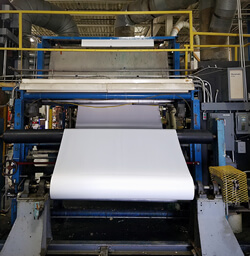Industrial Protective Coatings: What You Need to Know

What are industrial protective coatings?
On a very basic level, industrial protective coatings are protective layers we apply to various surfaces in an industrial capacity. We use them to shield surfaces from many different factors, including abrasion, as well as corrosion UV exposure, and chemical exposure. The reality is that many of the products we manufacture across the board are susceptible to damage without the proper protections; after all, they tend to experience a lot of stressors over the years. When you use these coatings, you’re not just protecting surfaces–you’re ensuring they last longer, as well. That means spending less money in the long term, with less worry about replacing products over and over. It’s more efficient and more logical.
Of course, you’ll find that these coatings have additional side benefits. Many manufacturers apply industrial protective coatings for their appearance, as well as their more practical enhancements. They may change the efficiency of the surface, too – adding smoothness or slickness, or creating a non-stick quality.
Keep in mind: there isn’t one single type of coating. In fact, protective industrial coatings come in many different forms. No matter what kind of product you’re working with, there’s an industrial coating match for its needs.
What are the different types of industrial protective coatings?
Epoxy coatings. Chances are, you’ve run into epoxy coatings at some point–they’re among the most commonly-used coatings on the market. Made up of an epoxy base combined with a curing agent, they’re more customizable than some of the alternatives. We can easily modify their ratios and formulations, ensuring that they’re perfectly made to fit each specific project we work with. Different formulations offer different properties–a polyamide epoxy coating utilizes resin, ensuring its moisture resistance. Conversely, a phenolic epoxy offers better chemical resistance. Overall, epoxy coatings are more durable than many others, which makes them resistant to typical weathering. However, they aren’t without weaknesses. They do not perform well when exposed to sunlight, which is why we often use them for submerged surfaces.
Zinc-rich coatings. When you’re ensuring that a coating provides a protective layer, this option may be a great choice. Reinforced with zinc dust, it comes in organic and inorganic forms. With an organic formulation, you’ll use an epoxy or polyurethane binder, while the inorganic formulation uses silicate binders. Used to protect steel, zinc-rich coatings are naturally quite durable, but can be vulnerable to alkaline substances and acids.
Acrylic coatings. Usually, we rely on these coatings for exterior surfaces–which makes them perfect for certain industrial applications. They retain their color, even when outdoors, and also act as primers, binding certain coatings to the right surfaces.
Alkyd coatings. These coatings don’t work quite as well in terms of durability. However, they yield a wonderfully glossy finish, and remain resistant to regular wear and tear.
Polyurethane coatings. A popular coating type, polyurethane coatings are both high-gloss and scratch-resistant. They’re among the most popular protective industrial coatings for a reason!
How do we apply specialized coatings in the industrial environment?
Although you’ll find a wide variety of different industrial protective coating applications, you’ll also discover that different application methods work for some of the same coating solutions. For you as a business owner, it’s just a matter of selecting the right method–and working with a manufacturer that can execute it properly for you.
Consider:
Dip Coating
Considered one of the most cost-effective application methods, we can execute it automatically or manually. In this case, we submerge the product in a liquid polymer, withdrawn at a constant rate, in a controlled setting regarding temperature and atmospheric pressure. It’s important to ensure that the system is contaminant-free before proceeding.
E Coating
A mixture of plating and painting, this process is also dependent on submersion–primarily dealing with water-based solutions including paint emulsions. We subject the solution and the part in question to electric currents, which condense the solution and form them over a part. What we like about this process is that it allows us to coat the product inside and out–if it’s a metal surface the solution can reach it, you’ll see it coated by the end.
Brushing
This is fairly simple–you just brush the coating on to the surface! Typically, we must apply multiple coats, and the brush bristles must be compatible with the coating we select.
Roll Coating
In this case, we rely upon rollers to apply all of the coating layers. Technically speaking, you’ll find a few different types of roll coating methods, and we can execute them either manually or automatically. Different methods suit higher volume orders, while others suit less complicated productions. No matter which one you select, we highly recommend consulting with a manufacturer ahead of time for advice.
Fortunately, no matter what product you need coated, and no matter which coating method you prefer, you don’t necessarily have to handle the process entirely on your own. Some business owners, for reasons having to do with cost efficiency, convenience, and consistency, choose to outsource their coating needs.
Curious about working with a third party manufacturer? Call Conversion Technologies International and speak with industry-leading experts at 419-924-5566 or contact us here.
- << < Previous Post
- 1
- 2
- ...
- 17
- ...
- 250
- 251 Next Post > >>

